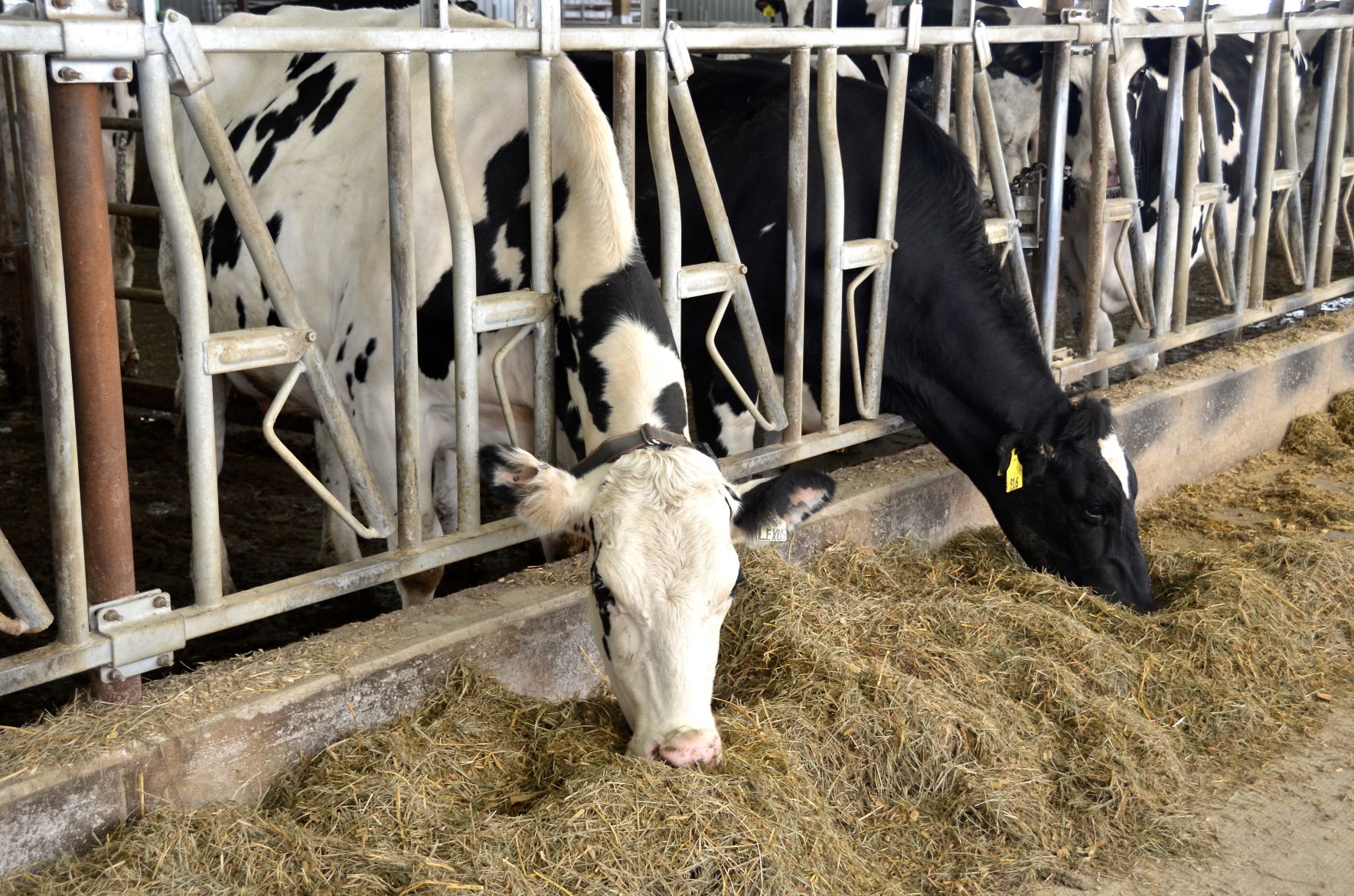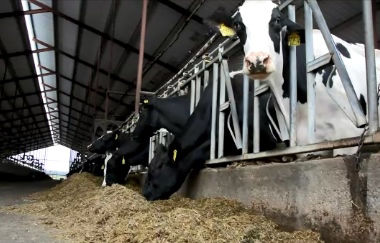Milk supply and demand are not on an even level, leading to tough economic times for dairy producers.
Bruce Jones, Extension dairy specialist at the University of Wisconsin-Madison Extension, said low milk prices, brought on by much more supply than demand, are taking a toll on dairy farms across the nation. “Thankfully feed prices are lower than they have been, which is keeping many producers with cash flow to stay in business,” Jones said.
The problem has been nearly 15 years in the making. In 2004, milk prices were high and sent a signal to producers for expansion. That led to a robust gain in production and thus to the current situation. The price for milk in 2004 increased 12.05 percent over 2003, well above the average yearly change for milk in all years 2004 through 2018.
That price increase allowed dairy farmers to expand herds and improve facilities. However, increases in input costs and cost of production have increased at a greater rate than the price received for milk, causing cash flow problems for dairy farmers.
Katie Pyle and her husband, David, own a dairy in Union Bridge, Maryland. Both grew up on dairy farms but started on their own in 2009 by renting facilities. They bought a farm in 2013. They milk 360 Jersey cows twice daily and have 140 other cattle—dry cows, heifers and calves—on their farm. The farm has only 87 acres of tillable ground and they purchase all their feedstuffs.
“To say we have been challenged recently is an understatement. The decline in milk prices has been hard for us because we are highly leveraged, being a new farm. The debt we have at the bank is not in our favor,” Katie Pyle said.
Pyle said they have had to sharpen their pencils when it comes to input costs and without the use of risk management, they likely wouldn’t still be in business. They only replace equipment when absolutely needed and shop around to get the best prices.
“We contract 70 percent of our production every month. One of the best things about the Jersey cows is they produce high quality milk, high in butterfat. The butterfat has really paid off for us,” Pyle said.
Reagan Bluel, University of Missouri Extension dairy specialist, said dairy producers have had to find a way to cut feed costs by reworking rations. With butterfat being a driver for profitability she stressed the importance of providing feedstuffs high in quality and fiber to support rumen health.
“Producers need to consider raising high quality silage and forages to keep production at its best. It may cost a little more for the seed, but in the end they will reap the benefits,” Bluel said.
Pyle said they choose not to raise their own feedstuffs so they can concentrate on the cows. However, that puts them at the mercy of their custom operators, some of whom have cows themselves.
“Our custom operators do a great job and raise high quality feed for us, but we know they will harvest their feed first,” Pyle said. “Nutrition is always top of mind on our farm. I sometimes feel like David is tweaking the ration daily because he wants to be cost effective. We work closely with our nutritionist to determine what we need to be feeding and where we can make changes.”
Pyle said the contract they have through Land O’Lakes has been important in having a place to send their milk. “They (Land O’Lakes) have been very instrumental in helping keep us profitable. David talks to them regularly to discuss nutrition, health and production,” she said.
Other dairy producers haven’t been so fortunate and have been told a production facility won’t be able to take milk that was normally delivered because demand for milk nationwide has decreased, according to Jones. This has led to some dire situations.
“Thankfully production facilities in Michigan and South Dakota will soon be going online and will help take some of the milk supplies in the upper Midwest,” Jones said. “Unfortunately, it won’t take them long to get to processing capacity even though there has been a hold on any expansion in the dairy industry.”
Price relief
Bluel said some price relief could be seen by summer after cows have slowed production when warmer temperatures move into high productions areas of the country.
“The trouble is, nationally we’ve seen fewer cows, but total milk volume hasn’t cut back. Or maybe this isn’t a problem. We want our cows to be efficient. The less efficient herds may be in trouble because cash flow is so important,” Bluel said.
Dairy farms with 500 or more cows could face challenges due to traditionally higher debt load than smaller operations, Jones said. Still, smaller operators don’t always have another generation who wants to take over the farm.
Bluel said no one is immune to loss in cash flow. “Dairy farmers are disheartened right now. One said to me he’s not sure why he keeps torturing himself,” she said.
Early in 2018, Missouri Gov. Eric Greitens included $660,000 in the state’s budget to fund a dairy risk management program created by the Missouri Dairy Revitalization Act. Bluel said dairy producers already saw some of these payments at the end of March.
On April 3, U.S. Secretary of Agriculture Sonny Perdue announced the enrollment period for the new and improved Margin Protection Program for Dairy will be open from April 9 to June 1.
“We recognize the financial hardships many of our nation’s dairy producers are experiencing right now,” Perdue said in a statement. “Folks are losing their contracts and they are getting anxious about getting their bills paid while they watch their milk check come in lower and lower each month. The Bipartisan Budget Act provided some much-needed incentives for dairy producers to make cost-effective decisions to strengthen their farms, mitigate risk and conserve their natural resources. This includes our support of America’s dairy farms. We encourage dairy producers to review the provisions of the updated program, which Congress shaped with their feedback. Those changes are now in effect, and I’d ask any producers who are interested to contact their local USDA service centers.”
Pyle said they have paid the administration costs for the MPP-Dairy in the past, but it didn’t help dairy producers who were losing money at catastrophic levels because feed costs in different regions weren’t accounted for and it would only cover up to a certain number of pounds of milk.
Changes in MPP-Dairy include: calculations of the margin period is monthly rather than bi-monthly; covered production is increased to 5 million pounds on the Tier 1 premium schedule; premium rates for Tier 1 are substantially lowered; and there will be an exemption from paying an administrative fee for limited resource, beginning, veteran and disadvantaged producers. Dairy operators enrolled in the previous 2018 enrollment period who qualify for this exemption under the new provisions may request a refund. More information on the program can be found at www.fsa.usda.gov/dairy.
International marketing
Jones said dairy exports are causing more uncertainty. International trade agreements and the North American Free Trade Agreement are vital to the dairy industry.
“The loss of export markets will put more pressure on the current markets,” Jones said. “If there is any more dip in prices, it could cause a dramatic exit for some producers.”
Dairy trade with Mexico totals $1.2 billion annually according to an Informa Economics analysis from a year ago. Mexico is the No. 1 market for U.S. dairy product exports, accounting for roughly one-fourth of total U.S. exports according to the U.S. Dairy Export Council.
“This analysis not only illustrates the importance of preserving existing market access to Mexico under North American Free Trade Agreement but also demonstrates why we are urgently pursuing new opportunities via U.S. free trade agreements around the globe,” said U.S. Dairy Export Council President and CEO Tom Vilsack. “Virtually every U.S. free trade agreement to date has yielded positive results for dairy, and current negotiations hold great potential for the industry.”
The relationship between the U.S. and Mexican dairy sectors is important for producers and the dairy economy.
“We are committed to working toward a modernized NAFTA agreement that preserves this open and dependable trade relationship with Mexico, while removing massive barriers to dairy trade with Canada that were not adequately addressed in the original agreement,” said Jim Mulhern, president and CEO of the National Milk Producers Federation.
The recent free trade agreement between the U.S. and South Korea is positive. South Korea was the fifth-largest U.S. dairy export market in 2017, accounting for $280 million in U.S. dairy sales. It is also the second-largest buyer of U.S. cheese after Mexico.
The recent agreement between the USDEC and China’s Jiangnan University to establish the U.S.-China Dairy Innovation Center will help develop China-friendly product formulations that incorporate U.S. dairy ingredients.
“This memorandum of understanding is further evidence of the U.S. industry’s desire to elevate its presence and demonstrate its commitment to meet the needs and desires of Chinese customers and consumers with sustainably produced U.S. dairy products,” Vilsack said.
Meanwhile, Missouri’s Bluel said with trade being such a sizable fraction of the U.S. dairy industry, it continues to be important for leaders to make progress in achieving these agreements.
“We know there are many things going on with the agricultural industry right now. To stay in business we must make the changes needed to be more profitable,” Pyle added. “Staying in close communications with those who want to help us stay in business is so important.”
Jennifer Carrico can be reached at 515-833-2120 or [email protected].

